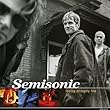Musical arc
It’s been said that the music you listen to as a young adult will — more often than not — be the music you’ll be listening to for the rest of your life. I’ve been trying to evaluate that axiom in terms of my own listening habits; so far the diagnosis is still quite muddy.
Like most people, my taste has evolved slowly and steadily; lately I feel as though I am settling down — not in the frequency in which I acquire music, but in the rate that I fall out of favor with certain bands or genres.
In my early years, I never listened to the radio and didn’t own any music. Exposure came from lying on the floor in my parents’ living room with an old Sears hi-fi record player and headphones massive enough to cause discomfort after a couple LPs. My parents’ collection was spotty at best. Random John Denver and Beatles albums. At least three albums by the now-obscure Mason Williams.
In the summer of 1989, I received a compilation tape of Beach Boys songs from my uncle in response to my positive reaction to the song “Kokomo”. A year later, I remember wanting to own M.C. Hammer’s breakout album Please Hammer Don’t Hurt ‘Em, and dancing around like a total loser to “Ice Ice Baby”. During this period, I was discovering vapid early nineties pop and listening to oldies. A few years later, I developed an intense obsession of the music of Ace of Base (my first pop CD). Throughout high school, I took to mostly mainstream rock (Weezer, then The Smashing Pumpkins) and pop and listened incessantly to commercial rock radio.
By the end of the nineties, I was acquiring CDs at an alarming rate of one every four or five days. It was as if I were making up for lost time. In 2000, I rediscovered the Beach Boys while taking a music appreciation class at Montgomery College. I embraced them with open arms and became a rapid Beach Boys completist almost overnight. At the same time, I began falling out of favor with commercial rock, especially that which is played on the radio. I started listening to more “indie” bands, more obscure sounds, more classic country, more underground bands.
 Which brings me to the point of this post: what (in addition to my own tastes) has changed? I’ll use Semisonic’s breakthrough 1998 album Feeling Strangely Fine as an example. If this album had been released nowadays, I would probably not even hear it, given my aversion to commercial pop and rock radio. If I did happen to hear it, I would probably brush it off, classify it as forgettable, and move on. But yet the album remains a classic in my own mind — dare I say, a minor masterpiece. I must acknowledge that I’m approaching the album with bias. I can’t evaluate it objectively because I continue to view the songs through a lens clouded with good memories: Buying my first car. The bittersweet relief of graduating from high school. The giddiness and elation of having a girlfriend. Becoming independent. Climbing up the lower rungs of the career ladder. Et cetera…
Which brings me to the point of this post: what (in addition to my own tastes) has changed? I’ll use Semisonic’s breakthrough 1998 album Feeling Strangely Fine as an example. If this album had been released nowadays, I would probably not even hear it, given my aversion to commercial pop and rock radio. If I did happen to hear it, I would probably brush it off, classify it as forgettable, and move on. But yet the album remains a classic in my own mind — dare I say, a minor masterpiece. I must acknowledge that I’m approaching the album with bias. I can’t evaluate it objectively because I continue to view the songs through a lens clouded with good memories: Buying my first car. The bittersweet relief of graduating from high school. The giddiness and elation of having a girlfriend. Becoming independent. Climbing up the lower rungs of the career ladder. Et cetera…
I look back fondly at music from my late teens, yet I recoil with disgust at some of the cookie-cutter “music” being released now. I used to follow the Billboard charts every week and know most of the songs. Now, I’m lucky if I can hum one or two songs in the top 40. I’ve come to realize that the deciding factor isn’t the music itself, but my emotional connection to it. I like to think that I evaluate music more objectively now, as a (mostly) level-headed adult. My appreciation of a new band or particular song won’t be influenced by frivolous things such as unrelated emotions. Or at least that’s my hope.








